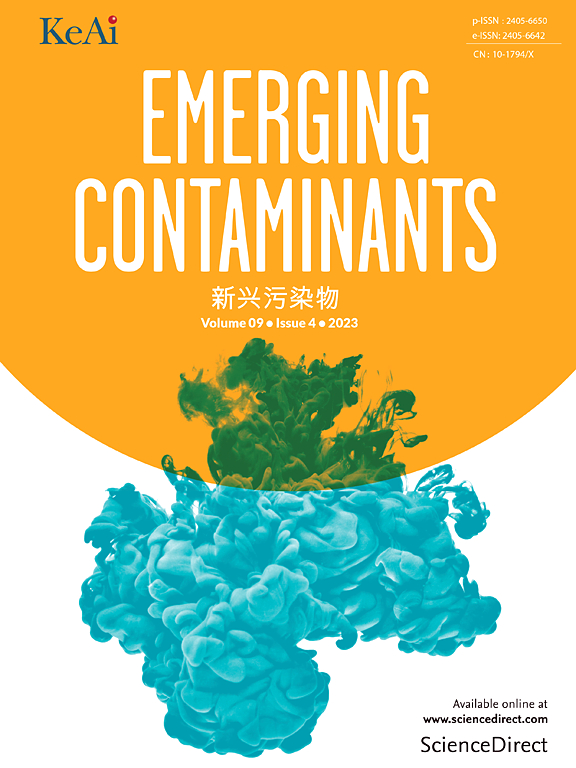四溴双酚a在混合反应器系统中的深度解毒:铁基三金属和好氧活性污泥法
IF 6.9
2区 环境科学与生态学
Q1 ENVIRONMENTAL SCIENCES
引用次数: 0
摘要
四溴双酚A (TBBPA)普遍存在于各种环境介质和生物基质中,由于其内分泌干扰、免疫毒性、神经毒性和致癌特性,造成了相当大的生态和健康风险。在这项研究中,我们开发了一种先进的矿化工艺,用于高效矿化TBBPA,利用混合系统,将零价铁(ZVI)技术与好氧活性污泥法相结合。为了提高ZVI降解TBBPA的催化效率,将铜和钯逐步沉积在ZVI上,合成了s-Fe0-Cu-Pd三金属材料。研究了Cu和Pd负载比、初始pH、三金属用量和TBBPA浓度对TBBPA降解的影响。与传统的ZVI和双金属体系相比,s-Fe0-Cu-Pd催化剂表现出优异的性能,在60 min内对TBBPA的降解率达到97.93%,其中BPA为主要降解产物。随后的好氧活性污泥处理促进了中间产物的完全降解,在10小时内实现了100%的BPA降解率。电化学分析(CV、EIS和LSV)和DFT计算表明,s-Fe0-Cu-Pd的氧化还原活性和电子传递效率增强。综合表征(SEM, XRD, XPS, ESR)和宏观基因组分析阐明了化学和生物降解机制,并提出了潜在的降解途径。本研究首次将基于zvi的三金属催化剂与好氧活性污泥相结合,以提高TBBPA的降解效率,为减轻TBBPA污染相关的生态风险提供了可持续的解决方案。本文章由计算机程序翻译,如有差异,请以英文原文为准。
The deep detoxification of tetrabromobisphenol a in a hybrid reactor system: Iron-based trimetallic and aerobic activated sludge methods
Tetrabromobisphenol A (TBBPA) is prevalent in various environmental media and biological matrices, posing considerable ecological and health risks due to its endocrine-disrupting, immunotoxic, neurotoxic, and carcinogenic properties. In this study, we developed an advanced mineralization process for the efficient mineralization of TBBPA, utilizing a hybrid system that combines zero-valent iron (ZVI) technology with an aerobic activated sludge method. A trimetallic material, s-Fe0-Cu-Pd, was synthesized by stepwise deposition of copper and palladium onto ZVI to improve its catalytic efficiency in degrading TBBPA. Optimal conditions for TBBPA degradation, including Cu and Pd loading ratios, initial pH, trimetallic dosage, and TBBPA concentration, were systematically investigated. The s-Fe0-Cu-Pd catalyst demonstrated superior performance compared to conventional ZVI and bimetallic systems, achieving 97.93 % degradation of TBBPA within 60 min, with BPA identified as the primary degradation product. Subsequent aerobic activated sludge treatment facilitated the complete degradation of intermediate products, achieving a BPA degradation rate of 100 % within 10 h. Electrochemical analyses (CV, EIS, and LSV) and DFT calculations demonstrated enhanced redox activity and electron transfer efficiency of the s-Fe0-Cu-Pd. Comprehensive characterization (SEM, XRD, XPS, ESR) and macrogenomic analysis were employed to elucidate the chemical and biological degradation mechanisms and to propose potential degradation pathways. This study represents the first integration of ZVI-based trimetallic catalysts with aerobic activated sludge to enhance TBBPA degradation efficiency, offering a sustainable solution for mitigating the ecological risks associated with TBBPA contamination.
求助全文
通过发布文献求助,成功后即可免费获取论文全文。
去求助
来源期刊

Emerging Contaminants
Medicine-Public Health, Environmental and Occupational Health
CiteScore
10.00
自引率
6.70%
发文量
35
审稿时长
44 days
期刊介绍:
Emerging Contaminants is an outlet for world-leading research addressing problems associated with environmental contamination caused by emerging contaminants and their solutions. Emerging contaminants are defined as chemicals that are not currently (or have been only recently) regulated and about which there exist concerns regarding their impact on human or ecological health. Examples of emerging contaminants include disinfection by-products, pharmaceutical and personal care products, persistent organic chemicals, and mercury etc. as well as their degradation products. We encourage papers addressing science that facilitates greater understanding of the nature, extent, and impacts of the presence of emerging contaminants in the environment; technology that exploits original principles to reduce and control their environmental presence; as well as the development, implementation and efficacy of national and international policies to protect human health and the environment from emerging contaminants.
 求助内容:
求助内容: 应助结果提醒方式:
应助结果提醒方式:


